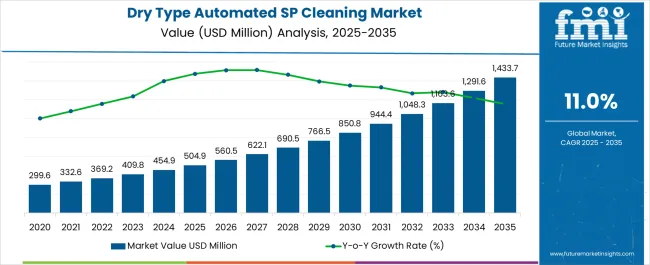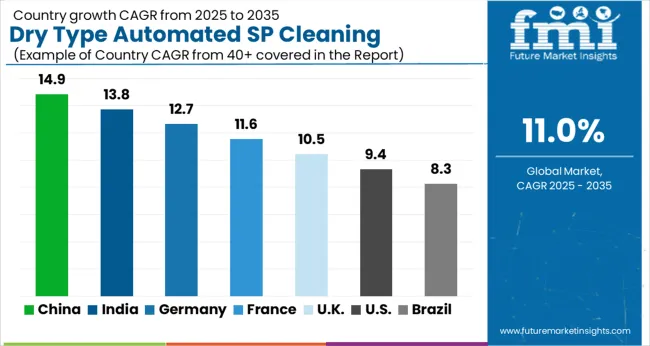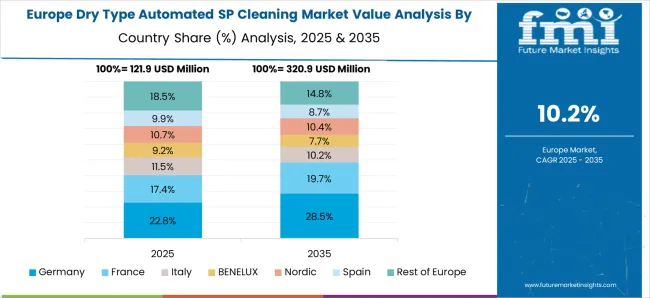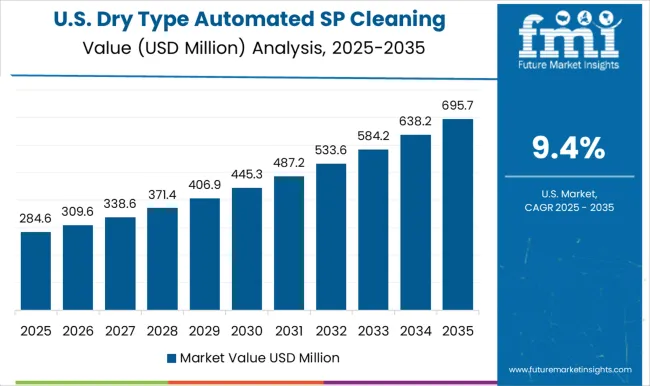The Dry Type Automated Solar Panel Cleaning Market is estimated to be valued at USD 504.9 million in 2025 and is projected to reach USD 1433.7 million by 2035, registering a compound annual growth rate (CAGR) of 11.0% over the forecast period. Asia Pacific emerges as the dominant contributor throughout the forecast period, reflecting large-scale solar installations in China, India, and Southeast Asian countries.
Early adoption from USD 504.9 million to USD 766.5 million indicates that low-cost labor alternatives and government-backed incentives for renewable energy projects have accelerated uptake of automated dry cleaning solutions. These solutions reduce maintenance costs and improve solar panel efficiency, which strongly influences regional market growth.
Europe follows as a secondary market, advancing from USD 622.1 million to USD 1,048.3 million across the forecast horizon. The European contribution is supported by stringent environmental regulations and aggressive renewable energy targets, driving the modernization of existing solar infrastructure.
Investments in smart cleaning technologies and integration with energy management systems further enhance growth, although high initial system costs moderate adoption compared to Asia-Pacific. North America shows comparatively moderate expansion from USD 690.5 million to USD 1,163.6 million, primarily reflecting slower large-scale adoption in residential solar segments and a concentration on utility-scale solar farms.
The regional imbalance is thus shaped by infrastructure scale, regulatory incentives, and cost-benefit alignment, with Asia-Pacific leading in market share, Europe contributing steadily, and North America demonstrating cautious growth.

| Metric | Value |
|---|---|
| Dry Type Automated Solar Panel Cleaning Market Estimated Value in (2025 E) | USD 504.9 million |
| Dry Type Automated Solar Panel Cleaning Market Forecast Value in (2035 F) | USD 1433.7 million |
| Forecast CAGR (2025 to 2035) | 11.0% |
The dry type automated solar panel cleaning market is expanding rapidly due to the global surge in solar energy adoption and the rising need for efficient maintenance solutions that ensure optimal panel performance. In arid and dust-prone regions, accumulation of dirt and debris significantly reduces energy output, prompting increased demand for waterless, automated cleaning systems.
These systems offer operational advantages by reducing manual labor, conserving water, and enabling remote operation, which aligns with the sustainability goals of solar plant operators. Technological innovation in robotics, sensor integration, and autonomous mobility is making dry cleaning solutions more accessible and scalable across utility and distributed energy projects.
The market outlook remains positive, as energy producers, residential users, and commercial facility owners increasingly seek low maintenance and environmentally sustainable cleaning technologies that support long-term efficiency and cost savings.
The dry type automated solar panel cleaning market is segmented by application and geographic regions. By application of the dry type automated solar panel cleaning market is divided into Residential, Commercial, and Industrial & utility. Regionally, the dry type automated solar panel cleaning industry is classified into North America, Latin America, Western Europe, Eastern Europe, Balkan & Baltic Countries, Russia & Belarus, Central Asia, East Asia, South Asia & Pacific, and the Middle East & Africa.

The residential application segment is expected to hold 48.60% of total market revenue by 2025, establishing it as the leading area of deployment. This dominance is being driven by the widespread installation of rooftop solar panels in urban and suburban regions and the growing need for low maintenance cleaning solutions that operate efficiently in smaller setups.
Dry type automated systems are particularly appealing for residential use as they eliminate water usage and reduce dependency on external cleaning services. Their compact design, ease of installation, and compatibility with smart home ecosystems have further boosted their acceptance among homeowners.
As residential solar adoption continues to climb globally, supported by government incentives and net metering policies, the need for effective panel maintenance has positioned this segment at the forefront of market growth.
The market has been expanding due to rising adoption of solar energy systems and the need for optimal panel efficiency. Dry cleaning solutions have been valued for their waterless operation, minimal maintenance, and environmental sustainability. Market growth has been reinforced by advancements in robotic cleaners, brush-based systems, and sensor-enabled automation. Increasing deployment of utility-scale and rooftop solar installations has further strengthened demand. The ability to reduce dust accumulation, improve energy output, and lower operational costs has positioned dry type automated cleaning systems as critical solutions for maintaining solar farm performance globally.
The market has been primarily driven by the rapid expansion of utility-scale solar farms. Dust, dirt, and bird droppings have been identified as factors that reduce panel efficiency, necessitating regular cleaning. Dry cleaning solutions have been preferred due to their waterless operation, which is essential in arid regions and locations with water scarcity. Robotic and automated cleaning systems have enabled scheduled maintenance with minimal human intervention, reducing labor costs and operational downtime. Integration with solar monitoring systems and IoT platforms has facilitated performance tracking and predictive cleaning cycles. Rising investments in renewable energy projects, coupled with governmental incentives for solar power adoption, have reinforced market demand for dry type automated solar panel cleaning systems worldwide.
Technological advancements have strengthened the market by improving cleaning precision, speed, and adaptability. Robotic cleaners equipped with rotating brushes, soft microfiber pads, and programmable motion paths have enabled uniform cleaning across panels without causing surface damage. Sensor-based navigation and real-time monitoring systems have allowed adaptation to panel tilt, layout, and dust intensity. Integration with smart controllers and cloud-based analytics has facilitated automated scheduling, operational alerts, and energy performance optimization. Furthermore, lightweight and modular designs have enabled easy deployment on large-scale solar farms and rooftop installations. These technological improvements have made dry cleaning systems highly efficient, minimizing energy loss, reducing labor dependence, and ensuring sustainable maintenance for solar energy infrastructure globally.
The market has been reinforced by adoption in rooftop, commercial, and industrial solar installations. Urban and commercial facilities have benefited from automated dry cleaning systems, which provide regular maintenance without water consumption or manual labor. Lightweight and compact designs have allowed installation on limited roof space while maintaining panel efficiency. Energy performance optimization, cost savings, and sustainability objectives have encouraged building owners and industrial operators to integrate automated dry cleaning solutions. Maintenance scheduling can be customized based on dust accumulation, seasonal changes, and environmental conditions. Increasing deployment of solar rooftops, coupled with corporate sustainability initiatives and green building certifications, has further strengthened market demand for waterless, automated solar panel cleaning solutions worldwide.
Despite growth, the market has faced challenges related to high initial investment, equipment durability, and terrain adaptability. Robotic systems require precision engineering to navigate panel arrays without causing damage or misalignment. Maintenance of moving parts, brush wear, and sensor calibration has influenced operational efficiency. Variability in panel layouts, surface coatings, and environmental conditions has necessitated customizable designs and programming. Manufacturers have responded with modular systems, lightweight construction, and remote monitoring features to address these challenges. Continuous improvements in automation, energy efficiency, and durability have ensured that dry type solar panel cleaning systems remain viable and effective solutions for maintaining performance across utility-scale, rooftop, and commercial solar installations globally.

| Countries | CAGR |
|---|---|
| China | 14.9% |
| India | 13.8% |
| Germany | 12.7% |
| France | 11.6% |
| UK | 10.5% |
| USA | 9.4% |
| Brazil | 8.3% |
The market is projected to grow at a CAGR of 11.0% from 2025 to 2035, driven by increasing solar energy installations, water scarcity concerns, and advancements in robotic cleaning technologies. China leads with a 14.9% CAGR, deploying large-scale solar farms and adopting advanced cleaning automation. India follows at 13.8%, scaling rapidly due to expanding solar infrastructure and government initiatives for renewable energy efficiency. Germany, at 12.7%, benefits from established solar markets and technological innovation in cleaning solutions. The UK, growing at 10.5%, focuses on improving solar panel efficiency through automation, while the USA, at 9.4%, witnesses’ steady adoption supported by industrial and utility-scale solar projects. This report includes insights on 40+ countries; the top markets are shown here for reference.
China is expected to witness a strong CAGR of 14.9%, driven by the rapid expansion of solar energy installations and the increasing adoption of automated cleaning technologies. Rising focus on efficiency, dust reduction, and maintenance cost optimization encourages the deployment of advanced dry-type cleaning systems. Large-scale solar farms, government incentives, and renewable energy policies further support market growth.
India is projected to grow at a CAGR of 13.8%, supported by expansion in utility-scale and rooftop solar installations. Increasing awareness about low-maintenance cleaning methods, high dust accumulation challenges, and government solar initiatives accelerate adoption. Rising investment in automation and operational efficiency further enhances market opportunities.

Germany is anticipated to register a CAGR of 12.7%, supported by advancements in solar farm maintenance technologies and automated cleaning solutions. Government incentives for renewable energy, focus on operational efficiency, and sustainable energy practices fuel market expansion. Demand for dust-free, high-efficiency solar panels encourages deployment of dry-type cleaning systems.
The United Kingdom is expected to grow at a CAGR of 10.5%, driven by renewable energy infrastructure growth and rising deployment of automated cleaning solutions. Increasing emphasis on reducing maintenance costs, ensuring high energy yield, and implementing efficient cleaning methods supports market expansion.

The United States is projected to experience a CAGR of 9.4%, fueled by the growth of large-scale solar farms and adoption of innovative cleaning technologies. Increasing investment in energy yield optimization, low-maintenance solutions, and automation enhances market potential. Rising government support for solar energy and sustainable infrastructure further drives adoption.

The market is witnessing notable growth driven by the rising deployment of large-scale solar installations and the need to maintain optimal panel efficiency. Key players such as Boson Robotics Ltd., BEIJING MULTIFIT ELECTRICAL TECHNOLOGY CO., LTD., and BladeRanger offer advanced robotic cleaning solutions designed to remove dust, debris, and particulate matter without water usage. These systems are particularly suited for arid regions, enabling sustainable and cost-effective maintenance of photovoltaic panels while reducing labor and operational expenses.
Companies like Ecoppia, Foshan Neexgent Energy Co., Ltd., and Hekabot provide scalable and automated solutions equipped with intelligent navigation, remote monitoring, and energy-efficient operation. Heliotex, Jurchen Technology GmbH, and NOMADD integrate advanced sensors and AI-driven algorithms into their cleaning devices, ensuring uniform cleaning coverage, minimal panel wear, and enhanced energy output. SolarCleano, SunBrush mobil GmbH, and Sharp Corporation further emphasize modular designs and adaptability to various panel configurations, supporting both utility-scale and commercial rooftop installations.
The increasing adoption of renewable energy and stringent performance standards for solar assets reinforces the market trajectory. By delivering innovative, water-free cleaning technologies, these leading providers enhance solar plant efficiency, reduce operational costs, and contribute to sustainable energy management practices globally. Their solutions address maintenance challenges while enabling long-term optimization of solar power generation.
| Item | Value |
|---|---|
| Quantitative Units | USD 504.9 Million |
| Application | Residential, Commercial, and Industrial & utility |
| Regions Covered | North America, Europe, Asia-Pacific, Latin America, Middle East & Africa |
| Country Covered | United States, Canada, Germany, France, United Kingdom, China, Japan, India, Brazil, South Africa |
| Key Companies Profiled | Boson Robotics Ltd., BEIJING MULTIFIT ELECTRICAL TECHNOLOGY CO.,LTD., BladeRanger, Ecoppia, Foshan Neexgent Energy Co.,Ltd., Hekabot, Heliotex, Jurchen Technology GmbH, NOMADD, scmsolar, Sharp Corporation, SolarCleano, SunBrush mobil GmbH, Wuxi Wanlv Intelligent Technology Co., Ltd., and Zhejiang Ganghang Solar Technology Co., Ltd. |
| Additional Attributes | Dollar sales by cleaning system type and panel application, demand dynamics across residential, commercial, and utility-scale solar installations, regional trends in solar maintenance adoption, innovation in automation, efficiency, and waterless cleaning technology, environmental impact of water and energy usage, and emerging use cases in large-scale solar farms and smart energy management. |
The global dry type automated solar panel cleaning market is estimated to be valued at USD 504.9 million in 2025.
The market size for the dry type automated solar panel cleaning market is projected to reach USD 1,433.7 million by 2035.
The dry type automated solar panel cleaning market is expected to grow at a 11.0% CAGR between 2025 and 2035.
The key product types in dry type automated solar panel cleaning market are residential, commercial and industrial & utility.
In terms of , segment to command 0.0% share in the dry type automated solar panel cleaning market in 2025.






Our Research Products

The "Full Research Suite" delivers actionable market intel, deep dives on markets or technologies, so clients act faster, cut risk, and unlock growth.

The Leaderboard benchmarks and ranks top vendors, classifying them as Established Leaders, Leading Challengers, or Disruptors & Challengers.

Locates where complements amplify value and substitutes erode it, forecasting net impact by horizon

We deliver granular, decision-grade intel: market sizing, 5-year forecasts, pricing, adoption, usage, revenue, and operational KPIs—plus competitor tracking, regulation, and value chains—across 60 countries broadly.

Spot the shifts before they hit your P&L. We track inflection points, adoption curves, pricing moves, and ecosystem plays to show where demand is heading, why it is changing, and what to do next across high-growth markets and disruptive tech

Real-time reads of user behavior. We track shifting priorities, perceptions of today’s and next-gen services, and provider experience, then pace how fast tech moves from trial to adoption, blending buyer, consumer, and channel inputs with social signals (#WhySwitch, #UX).

Partner with our analyst team to build a custom report designed around your business priorities. From analysing market trends to assessing competitors or crafting bespoke datasets, we tailor insights to your needs.
Supplier Intelligence
Discovery & Profiling
Capacity & Footprint
Performance & Risk
Compliance & Governance
Commercial Readiness
Who Supplies Whom
Scorecards & Shortlists
Playbooks & Docs
Category Intelligence
Definition & Scope
Demand & Use Cases
Cost Drivers
Market Structure
Supply Chain Map
Trade & Policy
Operating Norms
Deliverables
Buyer Intelligence
Account Basics
Spend & Scope
Procurement Model
Vendor Requirements
Terms & Policies
Entry Strategy
Pain Points & Triggers
Outputs
Pricing Analysis
Benchmarks
Trends
Should-Cost
Indexation
Landed Cost
Commercial Terms
Deliverables
Brand Analysis
Positioning & Value Prop
Share & Presence
Customer Evidence
Go-to-Market
Digital & Reputation
Compliance & Trust
KPIs & Gaps
Outputs
Full Research Suite comprises of:
Market outlook & trends analysis
Interviews & case studies
Strategic recommendations
Vendor profiles & capabilities analysis
5-year forecasts
8 regions and 60+ country-level data splits
Market segment data splits
12 months of continuous data updates
DELIVERED AS:
PDF EXCEL ONLINE
Automated Solar Panel Cleaning Market Size and Share Forecast Outlook 2025 to 2035
Solar Panel Cleaning Market Size and Share Forecast Outlook 2025 to 2035
Dry-type Air-core Smoothing Reactor Market Size and Share Forecast Outlook 2025 to 2035
Dry Cleaning Solvents Market Size and Share Forecast Outlook 2025 to 2035
Dry Type Distribution Transformer Market Size and Share Forecast Outlook 2025 to 2035
Dry Type Current Transformer Market Size and Share Forecast Outlook 2025 to 2035
Dry Type Transformer Market Size and Share Forecast Outlook 2025 to 2035
Dry-Cleaning and Laundry Services Market Growth, Trends and Forecast from 2025 to 2035
Solar Panel Market Size and Share Forecast Outlook 2025 to 2035
Solar Panel Recycling Management Market Size and Share Forecast Outlook 2025 to 2035
Solar Panel Mounting Structures Market Growth - Trends & Forecast 2025 to 2035
Solar Panel Tracking Mounts Market
Solar Component Cleaning Chemicals Market
India Solar Panel Mounting Structure Market Analysis and Forecast for 2025 to 2035
Laundry Facilities and Dry Cleaning Services Market analysis in United States Growth - Trends & Forecast 2025 to 2035
A Detailed Industry Analysis of Laundry Facilities and Dry Cleaning Services in the United States
Vehicle Integrated Solar Panels Market Size and Share Forecast Outlook 2025 to 2035
Aluminium Profiles for Solar Panel Market Size and Share Forecast Outlook 2025 to 2035
Type 3 Surge Protection Device Market Size and Share Forecast Outlook 2025 to 2035
Type 1 Surge Protection Device Market Size and Share Forecast Outlook 2025 to 2035

Thank you!
You will receive an email from our Business Development Manager. Please be sure to check your SPAM/JUNK folder too.
Chat With
MaRIA